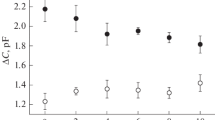Abstract
Inactivation of the membrane-bound ATPase by tight ADP binding was studied under nonenergized conditions. The energy state of the system was controlled either by omitting MgCl2, preventing ATP hydrolysis, or by addition of an uncoupler which dissipates the\(\Delta \overline \mu _{{\rm H}^ + } \). In the absence of Mg2+, ATP prevents the inactivation of the enzyme by ADP, in a competitive manner. This effect of ATP resembles that of GDP with Mg2+ present. In the presence of nigericin, Mg2+, and ATP, inactivation occurs after a 10–15-sec interval, during which the enzyme is able to hydrolyze ATP at a relatively rapid rate. The degree of inactivation is proportional to the level of bound ADP detected. This behavior is different from that of the coupled ATPase (no uncoupler added), where inactivation is attained only upon exhaustion of the ATP by its hydrolysis, despite the finding that ADP binds tightly to the active ATPase at all stages of the reaction. Higher levels of tightly bound ADP were detected in the presence of an uncoupler. We suggest that the interval during which the enzyme becomes inactive is that required for the enzyme to generate and bind ADP, and to change from the active to the inactive conformation. These results support the mechanism suggested previously for the modulation of the ATPase by tight nucleotide binding.
Similar content being viewed by others
References
Arnon, D. I. (1949).Plant Physiol. 24 1–15.
Bakker-Grunwald, T. (1974).Biochim. Biophys. Acta 368 386–392.
Bakker-Grunwald, T., and Van Dam, K. (1973).Biochim. Biophys. Acta 292 808–814.
Bar-Zvi, D., and Shavit, N. (1980a).FEBS Lett. 119 68–72.
Bar-Zvi, D., and Shavit, N. (1980b).Proceedings of the 5th International Congress on Photosynthesis (Akoyunoglou, G., ed.), Vol. 2, Balaban Int. Sci. Serv., Philadelphia, pp. 801–810.
Bar-Zvi, D., and Shavit, N. (1982).Biochim. Biophys. Acta. 681 451–458.
Bennun, A., and Avron, M. (1965).Biochim. Biophys. Acta. 109 117–127.
Carmeli, C. (1969).Biochim. Biophys. Acta 189 256–266.
Carmeli, C. (1970).FEBS Lett. 7 297–300.
Carmeli, C., and Avron, M. (1967).Eur. J. Biochem. 2 318–326.
Carmeli, C., and Lifshitz, Y. (1972).Biochim. Biophys. Acta 267 86–95.
Davenport, J. W., and McCarty, R. E. (1981).J. Biol. Chem. 256 8947–8956.
Dunham, K. R., and Selman, B. R. (1981).J. Biol. Chem. 256 212–218.
Gräber, P., Schlodder, E., and Witt, H. T. (1977).Biochim. Biophys. Acta 461 426–440.
Harris, D. H., and Slater, E. C. (1975).Biochim. Biophys. Acta 387 335–348.
Hochman, Y., and Carmeli, C. (1981).Biochemistry 20 6287–6292.
Lindberg, O., and Ernster, L. (1956).Method. Biochem. Anal. 3 1–24.
Magnusson, R. P., and McCarty, R. E. (1976).Biochem. Biophys. Res. Commun. 70 1283–1289.
Rienits, K. G. (1967)Biochim. Biophys. Acta 143 595–605.
Schumann, J., and Strotmann, H. (1980).Proceedings of the 5th International Congress on Photosynthesis (Akoyunoglou, G. ed.), Vol. 2, Balaban Int. Sci. Serv., Philadelphia, pp. 881–892.
Shavit, N. (1980).Ann. Rev. Biochem. 49 111–138.
Shavit, N., Aflalo, C., and Bar-Zvi, D. (1981). InEnergy Coupling in Photosynthesis (Selman, B. R., and Selman-Reimer, S., eds.), Elsevier/North-Holland, Amsterdam, pp. 197–207.
Shavit, N., and Strotmann, H. (1980).Methods Enzymol. 69 321–326.
Shoshan, V., Shahak, Y., and Shavit, N. (1980).Biochim. Biophys. Acta 591 423–433.
Slooten, L., and Nuyten, A. (1981).Biochim. Biophys. Acta 633 313–326.
Strotmann, H., Bickel, S., and Huchzermeyer, B. (1976).FEBS Lett. 61 194–198.
Author information
Authors and Affiliations
Rights and permissions
About this article
Cite this article
Bar-Zvi, D., Shavit, N. Modulation of the chloroplast ATPase by tight ADP binding. Effect of uncouplers and ATP. J Bioenerg Biomembr 14, 467–478 (1982). https://doi.org/10.1007/BF00743072
Received:
Revised:
Issue Date:
DOI: https://doi.org/10.1007/BF00743072




